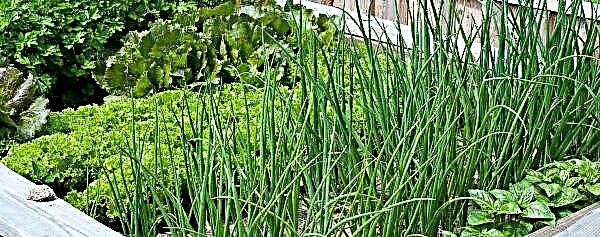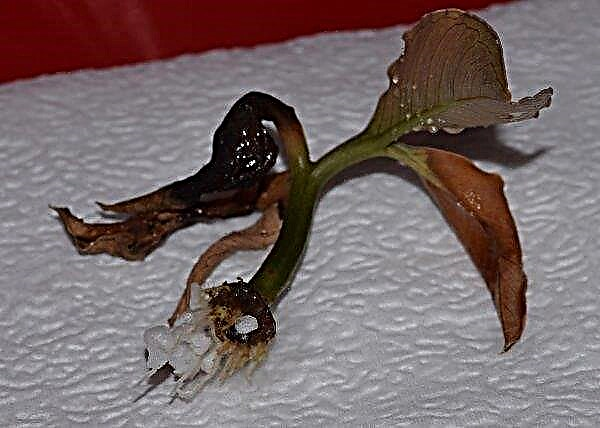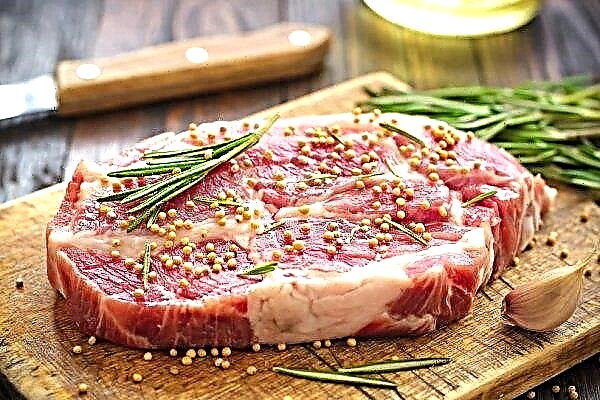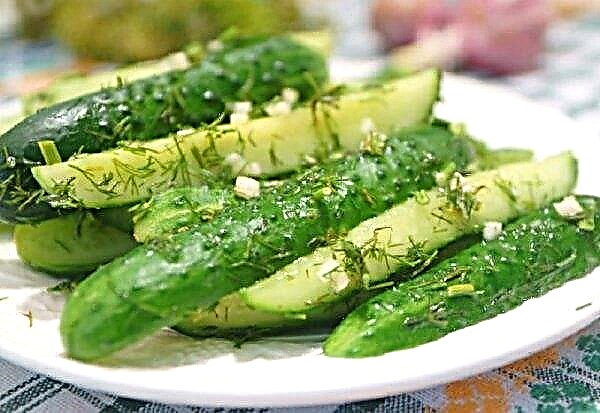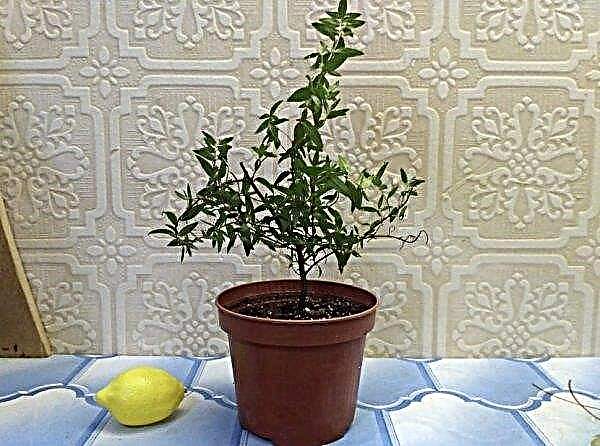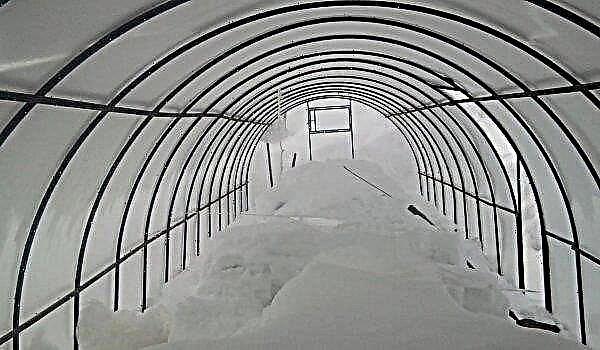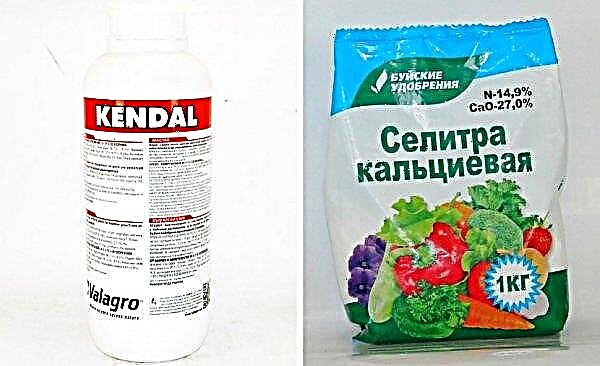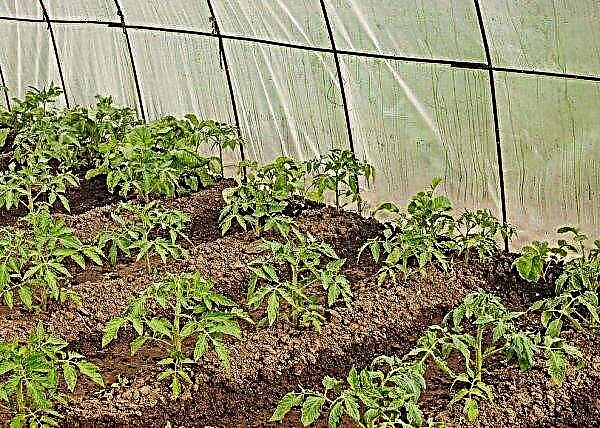Garlic crops with non-compliance with the rules of agricultural technology suffer from various fungal and viral diseases no less often than other plants on the site. About the most common ailments, pests that affect garlic, and how to combat them, read below.
The main causes of disease in garlic
Factors provoking the development of diseases of the garlic culture:
- high / low humidity, soil in combination with high / low temperature;
- non-observance of crop rotation rules;
- poor quality processing after harvesting;
- neglect of preventive tillage and seed;
- improper storage of the crop;
- watering with contaminated water;
- thickening of landings.
Many diseases can be carried on the paws of insect pests and downwind from neighboring sites.Did you know? In ancient India, garlic was used as an external medicine. It was not used in food due to the pungent smell and taste.

The main diseases of garlic and methods for their treatment
There are two main groups of diseases that affect the garlic culture:
- fungal - provoked by spores of fungi that winter in last year's foliage, harvested and topsoil;
- viral - provoked by viruses that settle in the soil and are stored in plant cells.
Fungal diseases
Fungal diseases of garlic crops include:
- fusariosis or root rot;
- neck rot;
- white rot;
- peronosprosis or downy mildew;
- penicillosis or green rot;
- aspergillosis or black mold;
- rust.
Root rot (Fusarium)
Fusarium most often manifests itself in a hot climate - the southern regions and, less commonly, the middle lane. If untreated, yield loss may be 80%. Fungal spores affect the seed directly in the soil. They winter in the upper layers of the soil and can be in sleep mode for a sufficiently long time, and with the onset of warm weather they begin to function actively. That is why it is very important to carry out high-quality cultivation of the soil during the autumn and spring preparation, as well as to select an integral planting material, since any damage to the teeth is an entrance for bacteria.
Bacteria begin to multiply actively at an air temperature of + 15 ° C and above, with high humidity.
The main signs of the disease are:
- loss of leaf density;
- yellowing of leaves and rapid drying, affecting primarily the tips;
- the appearance of strokes of brown strokes;
- the presence of pink plaque in the sinuses;
- softening of the heads, provoked by the development of Fusarium mycelium, which may have a white, pink or yellowish tint.
Root rot can be activated on an already harvested crop. This is facilitated by elevated temperature and high humidity in rooms intended for storage. The disease develops very quickly. Fusarium mycelium begins to form between the teeth, resulting in mummification of the heads.
For vegetative plants, Mikosan-B is suitable - a biological product based on fungal cells. First, all affected parts must be removed with a sharp alcohol-disinfected tool. After that, spray with a working solution - 100 ml / 3 l of water - this will be enough to process 100 m². The advantage of the drug is the ability to carry out processing at any stage of the growing season.
Important! «Mikosan-B "is not compatible with chemical fungicides.
Neck rot
Most often, cervical rot develops along with fusarium, bacteriosis, and green mold. The development of the disease provokes a weakening of the immunity of plants in the vegetative stage.
Signs of the disease appear on the harvested crop, stored or transported over long distances. The first to suffer are not fully ripened and not finished heads. In addition, the fungus can affect the seed during the ripening period of the bulbs. In this case, the main reason is poor-quality tillage after the previous harvest. The danger of the disease lies in the inability to determine its presence in the initial phase of development, therefore, infected heads end up in storage with healthy ones, which leads to a significant loss of yield.
The main manifestations:
- whitish spots with green borders in the lower part of the stem, which dry out and lead to breaking off of the ground part;
- the presence of gray spots in the upper part of the head, passing subsequently to the cloves.
The treatment regimen looks something like this:
- thorough drying of the harvested crop;
- maintaining in the storage temperature 0 ... + 2 ° С at a humidity of 70%;
- weekly examination of the bulbs and elimination of affected specimens;
- processing of teeth before planting with 0.2% Fundazole solution;
- prophylactic treatment with EM drugs at all phases of the growing season in order to increase plant immunity;
- foliar top dressing with urea at the rate of 10 g of substance per 10 l of water.
Did you know? In San Francisco, the Garlic Restaurant offers its visitors a wide variety of dishes, all of which are seasoned with garlic. Among the variety of exotics presented on the menu, there is even ice cream with garlic.
White rot
It affects vegetative plants and crops laid for storage. The causative agent hibernates in the upper layers of the soil and on root crops. The spore activation phase is observed when the temperature drops to + 10 ° C in combination with high humidity.
The main manifestations:
- yellowing of leaves in the stage of active vegetation;
- the presence of white plaque (mycelium) on the fruit;
- increased water content of teeth, followed by decay.

Downy mildew (peronosporosis)
Peronosporosis actively progresses in regions with high humidity. The disease quickly spreads in the wind, through the soil, transmitted from healthy plants to healthy plants. The fungus dies in the presence of a source of bright light and with an increase in air temperature. This feature of the vital activity of the fungus is the basis for choosing preventive and radical control measures.
The main symptoms are:
- yellowing and drying of leaves;
- delayed plant development.
Did you know? You can eliminate the bad breath of garlic from the mouth by chewing parsley or cardamom seeds.
Green mold (penicillosis)
Activation of the fungus occurs 2-3 months after the laying of the crop for storage. The development of the disease contributes to increased humidity and the presence of damage to the garlic heads.
The main manifestations:
- drying individual teeth;
- the presence of yellowish spots-depressions on the wedges;
- the appearance of whitish mold, eventually changing color to green;
- color change lobules;
- conversion of lobules into dust of green or bluish tint.
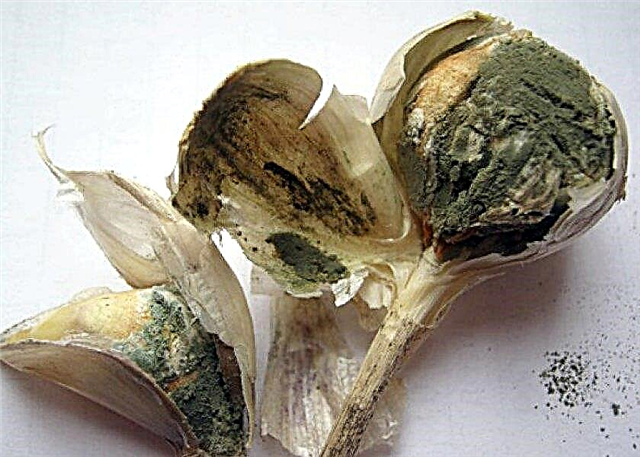
Black mold (aspergillosis)
The fungus progresses in a warm, humid environment. Most often manifested in an already harvested crop when storage rules are not followed. Spores can persist in the soil, on plant debris. The risk of developing the disease significantly increases when the ground part of plants at elevated temperatures stays wet for more than 6 hours.
Manifestations of aspergillosis:
- the presence of gray-black spots on the covering scales of the heads;
- softening lobules;
- complete tooth decay.
Important! Frequent and excessive use of drugs containing copper chloride (Bordeaux liquid, vitriol, "Hom") leads to the accumulation of copper salts in root crops, which is harmful to the human body.
Rust
The cause of the disease is spores wintering in plant debris and topsoils.
The main manifestations:
- yellow lines on the leaves, gradually increasing in size and covering the entire area of the ground part;
- loss of leaf part, as a result of which the heads lose their nutrition and do not mature;
- decrease in commodity and quality indicators of the crop.

Garlic Viral Diseases
Viral infections that can affect garlic include:
- mosaic;
- yellow dwarfism.
Mosaic
Mosaic virus is introduced into the composition of chloroplasts and in the process of its life destroys them. More often manifested on leaves damaged by mechanical means. The virus actively multiplies at high humidity and air temperature +19 ... + 24 ° С. Viral cells are stored in plant debris, soil, and harvested crops. The mosaic virus is a tick.
Mosaic is manifested by a change in the color of the leaves. Yellow, light green and necrotic spots or stripes appear on the ground part of plants, which can have different sizes and are arranged in a chaotic order. Over time, the leaves lose turgor and become deformed.
As a treatment, "Karbofos" is used. 50 g of dry powder is added to 10 liters of water - this solution will be enough to process 100 m². Before processing, all plants infected with the virus are dug up and burned outside the site.
Did you know? In ancient Egypt, it was believed that garlic helps to increase the physical strength of a person. In this regard, this ingredient was an essential element of the menu of builders involved in the construction of pyramids.
Yellow dwarfism
Virus cells are stored only in bulbs, with pollen and are not transmitted through the soil. The incubation period on an individual plant is 7-14 days.
Symptomatic picture:
- yellow stripes on the leaves;
- loss of turgor and deformation of the sheet;
- stunting;
- reducing the size of the bulbs.
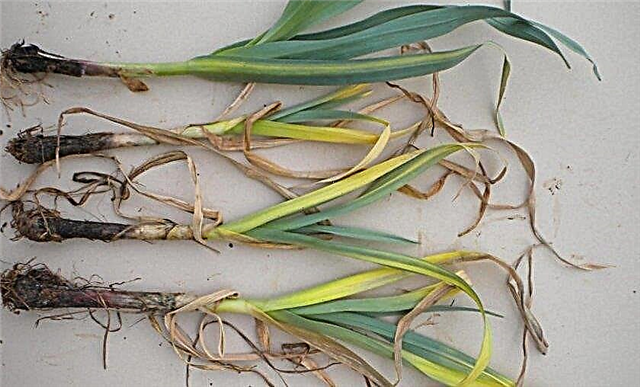
When infected plants appear on the site, they need to be dug up and burned. Then carry out prophylactic treatment with EM drugs and adjust the feeding regimen.
Pests
The main pests that can be carriers of diseases:
- Onion fly - from the second half of May, females begin to lay eggs at the base of leaf plates or directly to the soil. The larvae penetrate the inside of the garlic heads and destroy the upper covering flakes, as a result of which the growth slows down sharply, the leaves fade, and the wedges soften and begin to rot, exiting an unpleasant odor. As a treatment, tobacco infusion with red pepper is suitable. 250 g of tobacco dust and 2 tsp are added to 3 liters of boiling water. ground red pepper. The infusion is cooled to + 30 ° C, then water is added to obtain a volume of 10 l, and watering is carried out in combination with leaf spraying.

- Onion moth - winters in the upper layers of the soil. It spreads rapidly with the onset of heat. Lays eggs at the base of the leaf and on the beds themselves. The first generation of larvae appears in May - early June. Evidence of the presence of this pest are longitudinal dark stripes on the leaves. As a treatment, tobacco infusion with red pepper is used, as for an onion fly.
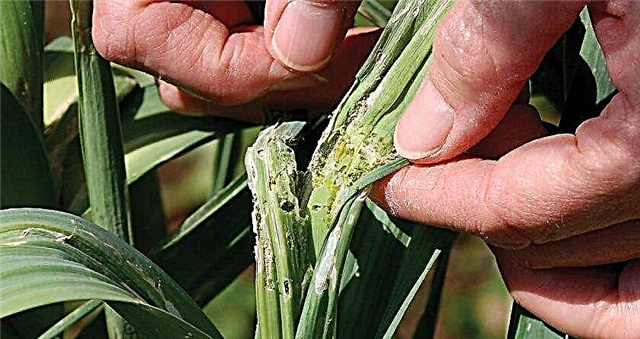
- Garlic nematode - There are three types of nematodes that infect garlic: gall, stem and root. The pest belongs to filamentous worms. The main symptom is a delayed root development, accompanied by the appearance of inclusions of an uncharacteristic yellow or brown color. Watering with 5% manganese solution is effective.

- Tobacco thrips - winters in the upper layers of the soil. Females lay eggs in the leaves. Larvae feed on the juice of foliage, as a result of which the stems wilt, and the crop does not ripen completely. To combat thrips use celandine infusion. For 10 l of boiling water add 1 kg of celandine tops and insist a day. After this, the infusion is filtered and sprayed.

- Root tick - most often distributed in storage. The cause of infection is the failure to comply with preventive measures when buying and before planting seed garlic. The pest penetrates through the bottom to the lobules and eats fleshy scales, as a result, the inside of the head rots out. To prevent its spread in storages, two days before the laying of the crop, the gamma checkers are burned.

The rules for growing healthy garlic
To get a healthy harvest of garlic, you need to consider the rules of crop rotation. Culture can be returned to its original place after 4 years.
Bad precursors for garlic are:
- bow;
- legumes;
- cabbage;
- potatoes;
- cereals;
- carrot;
- beet.
The next step is soil preparation. It is carried out in the fall and in the spring.Did you know? The composition of garlic includes more than 100 chemically active elements.
Includes a number of events:
- in the fall - harvesting plant debris and weeds;
- cultivation to a depth of 30 cm;
- soil treatment with 1% solution of copper sulfate;
- a week later - the application of 10 kg of fresh manure for every 1 m² and cultivation to a depth of 20 cm;
- in spring - soil treatment with copper sulfate (can be replaced with an EM preparation) and cultivation to a depth of 30 cm;
- in a week - applying dry manure or compost of 10 kg / m², followed by cultivation to a depth of 20 cm.

In the furrows, the teeth are placed at a distance of 5-7 cm. Then they cover them with a layer of soil and mulch with compost. With the appearance of the first 2-3 leaves, the soil in the aisles and in the root circle is loosened, and then mulched with peat. Watering is carried out as the soil dries up, on average once a week, 10 liters of water per 1 m². After watering, loosening should follow with parallel removal of weeds, inspection of plants for damage by diseases and pests.
In the phase of the appearance of 3-4 sheets, urea is fertilized - 1 tbsp. l. / 10 l of water. Watering is carried out using a watering can by sprinkling, that is, moisture must fall not only on the soil, but also on the leaves. After a fortnight, the root dressing is carried out with a nitroammophos - 2 tbsp. l. / 10 l of water.
In the summer, the number of irrigations is gradually reduced, stopping them completely 3 weeks before harvesting. In June, the last feeding with a solution of wood ash (per 10 l of water 400 g of ash) or superphosphate (2 tbsp. L / 10 l of water) is carried out. In July, the arrows, reaching a height of 10 cm, break off to redirect the forces of the plant to the formation of heads. For propagation by bulbs, arrows leave only 3-5 plants.Important! Nitrogen-containing fertilizers, including manure, are applied to the beds with garlic exclusively in the initial phase of the growing season. Otherwise, the plants will actively grow green mass and do not have time to fully form the heads.
Garlic harvest usually occurs in July. More precisely, the timing is determined by the appearance of the plants. When the lower leaves begin to turn yellow and fade, and the air boxes open, the garlic is ready for harvest. You need to dig out the garlic in dry sunny weather. After digging it up, it is collected in sheaves and suspended to dry in a well-ventilated, dry room for several days, maintaining the air temperature within + 25 ° С. After drying, the tops are removed, leaving tips 5 cm long. Next, the garlic is sorted and hung in nets under the ceiling in the basement.
Optimal storage conditions:
- humidity - 70%;
- air temperature - + 2 ° С.

General preventive measures
A general preventive measure is the implementation of all agrotechnical rules:
- crop rotation compliance;
- selection of varieties adapted to the climate conditions of a particular region;
- high-quality deep soil aeration at the stages of autumn and spring preparation;
- preventive soil treatment with fungicides and EM preparations at the preparation stages;
- compliance with watering, fertilizing;
- loosening of the soil in the turning circle and row spacing after each moistening of the soil by natural or artificial means;
- high-quality disinfection treatment of planting material;
- drying of the harvested crop and maintaining optimal conditions in storage.











